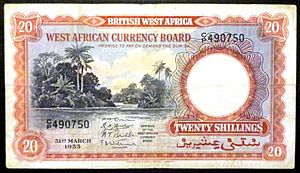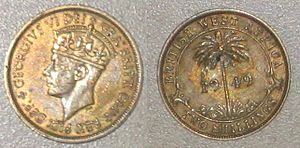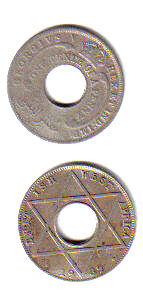British West African pound facts for kids
The British West African pound was the money used in several British areas in West Africa. These areas included Nigeria, Ghana (then called the Gold Coast), Sierra Leone, and the Gambia. It was worth the same as one British pound and was divided into 20 shillings. Each shilling was then split into 12 pence.
Contents
A Look Back: The History of the Pound
In the 1800s, the money used in British West Africa was the British pound. Regular British coins were used there. But something interesting happened: these British coins often left West Africa and went back to the UK! This meant there weren't enough coins left for people to use in West Africa.
To fix this, in 1912, a group in London created the West African Currency Board. This board started making special coins just for British West Africa. These unique coins wouldn't be accepted in shops in Britain, so they would stay in West Africa, helping to keep enough money in circulation.
Other countries also used the British West African pound:
- Liberia started using it in 1907, replacing their own money. However, Liberia switched to the US dollar in 1943.
- Togo and Cameroon began using this currency in 1914 and 1916. This happened after British and French troops took over these areas from Germany during World War I.
New Money: When the Pound Changed
Starting in 1958, the British West African pound was slowly replaced. Each area began to use its own new money. Here's a quick look at when and how these changes happened:
| Country | Year of Change | New Money | How it Changed |
| Western Nigeria | 1958 | Nigerian pound | 1 British West African pound became 1 Nigerian pound |
| Ghana | 1958 | Ghanaian pound | 1 British West African pound became 1 Ghanaian pound |
| Nigeria | 1958 | Nigerian pound | 1 British West African pound became 1 Nigerian pound |
| British Cameroon | 1961 | CFA franc (BEAC) | 1 British West African pound became 700 CFA francs |
| Sierra Leone | 1964 | Leone | 1 British West African pound became 2 Leones |
| Gambia | 1965 | Gambian pound | 1 British West African pound became 1 Gambian pound |
Coins of British West Africa
The first coins for British West Africa were made in 1907. They included very small values like 1⁄10d (a tenth of a penny) and 1d (one penny). Interestingly, these coins had a hole in the middle!
Over the years, the coins changed:
- In 1913, silver coins for 3d, 6d, 1 shilling, and 2 shillings were introduced.
- By 1920, brass was used instead of silver for these coins.
- In 1938, new, larger 3d coins were made.
- The last coins for British West Africa were made in 1958.
Banknotes of British West Africa
The West African Currency Board started printing paper money (banknotes) in 1916.
- The first notes were for 2 shillings, 10 shillings, and 20 shillings (£1).
- In 1918, 1 shilling notes were also made.
- After 1918, only the 10 shilling and 20 shilling notes were commonly used.
- Bigger notes, worth 100 shillings (£5), were introduced in 1953.
- The very last banknotes were printed in 1962.
See also
- Biafran pound
- British currency in Oceania
- British currency in the Middle East
- British currency in the South Atlantic and the Antarctic
- British currency in the West Indies
- Gambian pound
- Ghanaian pound
- Gold Coast ackey
- Nigerian pound
- West African Monetary Zone
- Economic Community of West African States




